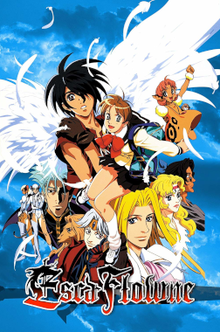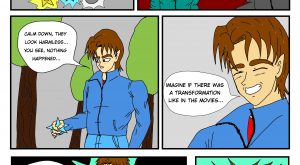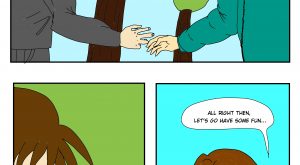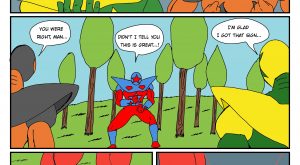The Vision of Escaflowne (manga)
The Vision of Escaflowne (Japanese: 天空のエスカフローネ, Hepburn: Tenkū no Esukafurōne, lit. Escaflowne of the Heavens) is a 26-episode Japanese anime television series created by Shōji Kawamori and Sunrise Studios and directed by Kazuki Akane. It premiered in Japan on April 2, 1996 on TV Tokyo, and the final episode aired on September 24, 1996. Sony’s anime satellite channel, Animax also aired the series, both in Japan and on its various worldwide networks, including Hong Kong, Taiwan, and Southeast Asia. The series was licensed for Region 1 release by Bandai Entertainment. It is currently licensed by Crunchyroll.
The series follows a teenage high school girl named Hitomi, who finds herself pulled from Earth to the planet Gaea when a boy named Van appears on the high school track while battling a dragon. In Gaea, she is caught in the middle of a war as the Zaibach Empire attempts to take over Gaea. Van (King of Fanelia), with aid from Allen (an Asturian Knight), commands his mystical mech Escaflowne in the struggle to stop the Zaibach Empire. Hitomi’s fortune telling powers blossom in Gaea as she becomes the key to awakening Escaflowne and to stopping Zaibach’s plans.
While the anime series was in production, two very different manga retellings were also developed and released: a shōnen version of the story entitled The Vision of Escaflowne and a shōjo retelling titled Hitomi — The Vision of Escaflowne. In addition, a second shōjo adaptation called Escaflowne — Energist’s Memories was released as a single volume in 1997. The story was novelized in a series of six light novels by Yumiko Tsukamoto. A movie adaptation, entitled simply Escaflowne, was released on June 24, 2000, but bears only a basic resemblance to the original series. Four CD soundtracks and a drama CD have also been released in relation to the series.
Plot
Gaea is an alternate dimension that was created from the combined wishes of the inhabitants of Atlantis when it started to sink into the ocean. Gaea has 100 countries. On Gaea, Earth is known as the Mystic Moon. Gaea’s size, mass, atmospheric composition, temperature belts, and even seasons are the same as Earth’s, although its gravity is lower, as implied by some of the jumps and acrobatic feats of some of the show’s characters.
The series focuses on Hitomi Kanzaki and her adventures after she is transported to the world of Gaea, a mysterious planet where she can see Earth and its moon in the sky. Hitomi’s latent psychic powers are enhanced on Gaea and she quickly becomes embroiled in the conflicts between the Zaibach Empire led by Emperor Isaac Dornkirk and the several peaceful countries that surround it. The conflicts are brought about by the Zaibach Empire’s quest to revive the legendary power from the ancient city of Atlantis. As the series progresses, many of the characters’ pasts and motivations, as well as the history of Atlantis and the true nature of the planet Gaea, are revealed.
Anime
The Vision of Escaflowne premiered in Japan on TV Tokyo on April 2, 1996 where it aired weekly until it completed its twenty-six-episode run on September 24, 1996. Bandai Entertainment‘s North American division, which licensed the series for home video distribution under its AnimeVillage label, first released the series with English subtitles, across eight VHS volumes, including a box set, from September 15, 1998 to December 15, 1998. In August 2000, Fox Kids Network began broadcasting the series in the United States. Produced by Saban Entertainment under license by Bandai Entertainment, these dubbed episodes were heavily edited to remove footage, add new “flashback” sequences to remind the audience of the events that just occurred, and to heavily downplay the role of Hitomi in the series. The first episode was skipped altogether, and the series soundtrack produced by Yoko Kanno was partially replaced with more techno rearrangements by Inon Zur. This modified version of the series was canceled after ten episodes due to “low ratings”. Fox explained that they edited to meet their own target audience, to comply with broadcast standards, and to fit the allowed timeslot.[failed verification] The Canadian television channel YTV acquired Fox’s dubbed version of the series for broadcast. Following Fox’s planned broadcast schedule, they premiered the series on September 11, 2000 with the second episode. YTV aired all of the episodes Fox Kids dubbed, concluding with the series true first episode in February 2001. Bandai began releasing the dubbed version to VHS in 2000, discontinuing the releases in February 2001 after only four volumes had been released.
Bandai later released the entire series, unedited and in the original episode order, to Region 1 DVD. Spanning eight volumes, the releases include the original Japanese audio tracks with optional English subtitles, and the uncut English dubbed track. Bandai also later released the series in several different box sets, including a Limited Edition set released on July 23, 2002, a “Perfect Collection”—which included the Escaflowne feature-length movie—released October 26, 2004, and an “Anime Legends” box set on April 11, 2006. At Otakon 2013, Funimation had announced that they have acquired both licenses to The Vision of Escaflowne and the movie. On February 27, 2016, Funimation launched a Kickstarter campaign to re-dub the Escaflowne TV series using the HD materials from Sunrise, with the goal of $150,000.
Three pieces of theme music are used for the series. “No Need for Promises” (約束はいらない, Yakusoku wa Iranai), performed by Maaya Sakamoto, is used for the series opening theme for the entire series, except the first episode in which no opening sequence is used. Performed by Hiroki Wada, “Mystic Eyes” is used for the ending theme for the first twenty-five episodes, while the final episode uses Yoko Kanno‘s instrumental piece “The Story of Escaflowne ~ End Title” (ザ ストーリー オブ エスカフローネ~エンド タイトル, Za Sutoorii Obu Esukafuroone ~ Endo Taitoru).
Manga
Three alternate retellings of The Vision of Escaflowne have been released in manga form, with first two manga series developed at the same time as the anime. Due to the radical changes in the anime series during production, these two manga series are very different from the original anime series and each other. The first series, also titled The Vision of Escaflowne was one of the first manga series to appear in the then new Shōnen Ace magazine from Kadokawa Shoten. Despite the anime series itself being on hold, Sunrise gave artist Katsu Aki the existing production and character designs, resulting in the first manga series having the heavy shōnen feel and curvaceous Hitomi that was originally planned for the anime series. Given free rein to change the story however he wanted, Aki’s version is a violent saga focused primarily on fighting and has Hitomi transforming into a “curvaceous nymph” that is the power source of the mecha Escaflowne. The series premiered in Shōnen Ace’s first issue on October 24, 1994 and ran until November 26, 1997. The thirty-four chapters were collected and published by Kadokawa across eight tankōbon volumes. It was licensed for released in North America by Tokyopop with the first volume released on July 8, 2003. The Tokyopop English editions were also imported for distribution in Australia by Madman Entertainment.
| The Vision of Escaflowne | |

Limited Edition DVD box set
|
|
| 天空のエスカフローネ (Tenkū no Esukafurōne) |
|
|---|---|
| Genre | Fantasy, mecha, romance, isekai |
| Created by | Hajime Yatate, Shōji Kawamori |
| Manga | |
| Written by | Shōji Kawamori |
| Illustrated by | Katsu Aki |
| Published by | Kadokawa Shoten |
| English publisher | |
| Magazine | Shōnen Ace |
| Demographic | Shōnen |
| Original run | October 24, 1994 – November 26, 1997 |
| Volumes | 8 |
| Anime television series | |
| Directed by | Kazuki Akane |
| Produced by | Yumi Murase (TV Tokyo) Masahiko Minami (Sunrise) |
| Written by | Hiroaki Kitajima Shōji Kawamori Ryota Yamaguchi Akihiko Inai |
| Music by | Hajime Mizoguchi Yoko Kanno |
| Studio | Sunrise |
| Licensed by | |
| Original network | TV Tokyo |
| English network | |
| Original run | April 2, 1996 – September 24, 1996 |
| Episodes | 26 |
| Manga | |
| Messiah Knight: The Vision of Escaflowne | |
| Written by | Yuzuru Yashiro |
| Published by | Kadokawa Shoten |
| Magazine | Asuka Fantasy DX |
| Demographic | Shōjo |
| Original run | April 18, 1996 – January 18, 1997 |
| Volumes | 2 |
| Light novel | |
| Written by | Yumiko Tsukamoto |
| Illustrated by | Nobutoshi Yuuki Hirotoshi Sano |
| Published by | Kadokawa Shoten |
| Magazine | Newtype |
| Original run | June 1996 – August 1997 |
| Volumes | 6 |
| Manga | |
| Escaflowne: Energist’s Memories | |
| Written by | Various |
| Published by | Kadokawa Shoten |
| Demographic | Shōjo |
| Published | January 8, 1997 |
| Volumes | 1 |
| Anime film | |
|
|






Mendaftar di www.binance.com
Can you be more specific about the content of your article? After reading it, I still have some doubts. Hope you can help me. https://accounts.binance.com/id/register-person?ref=WTOZ531Y